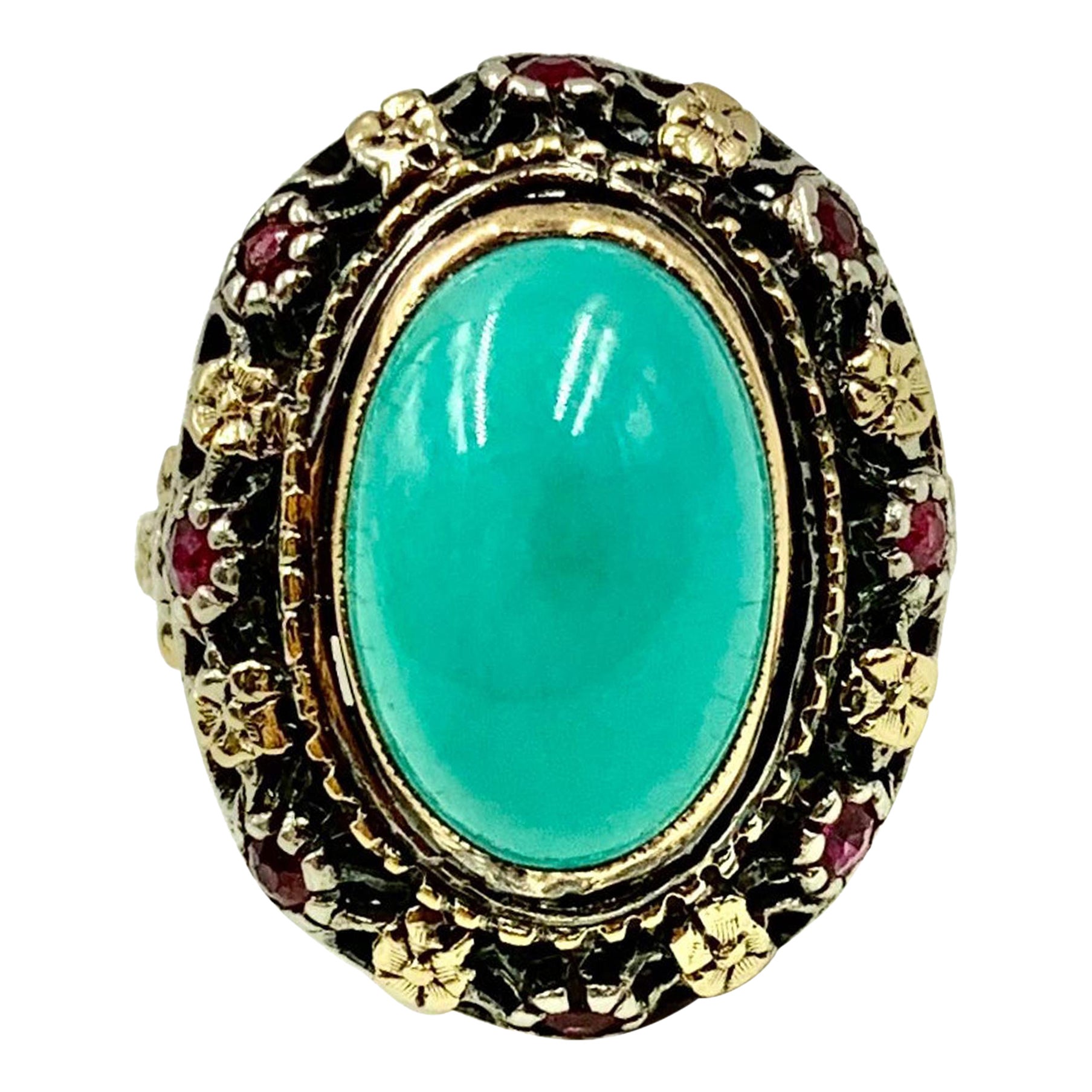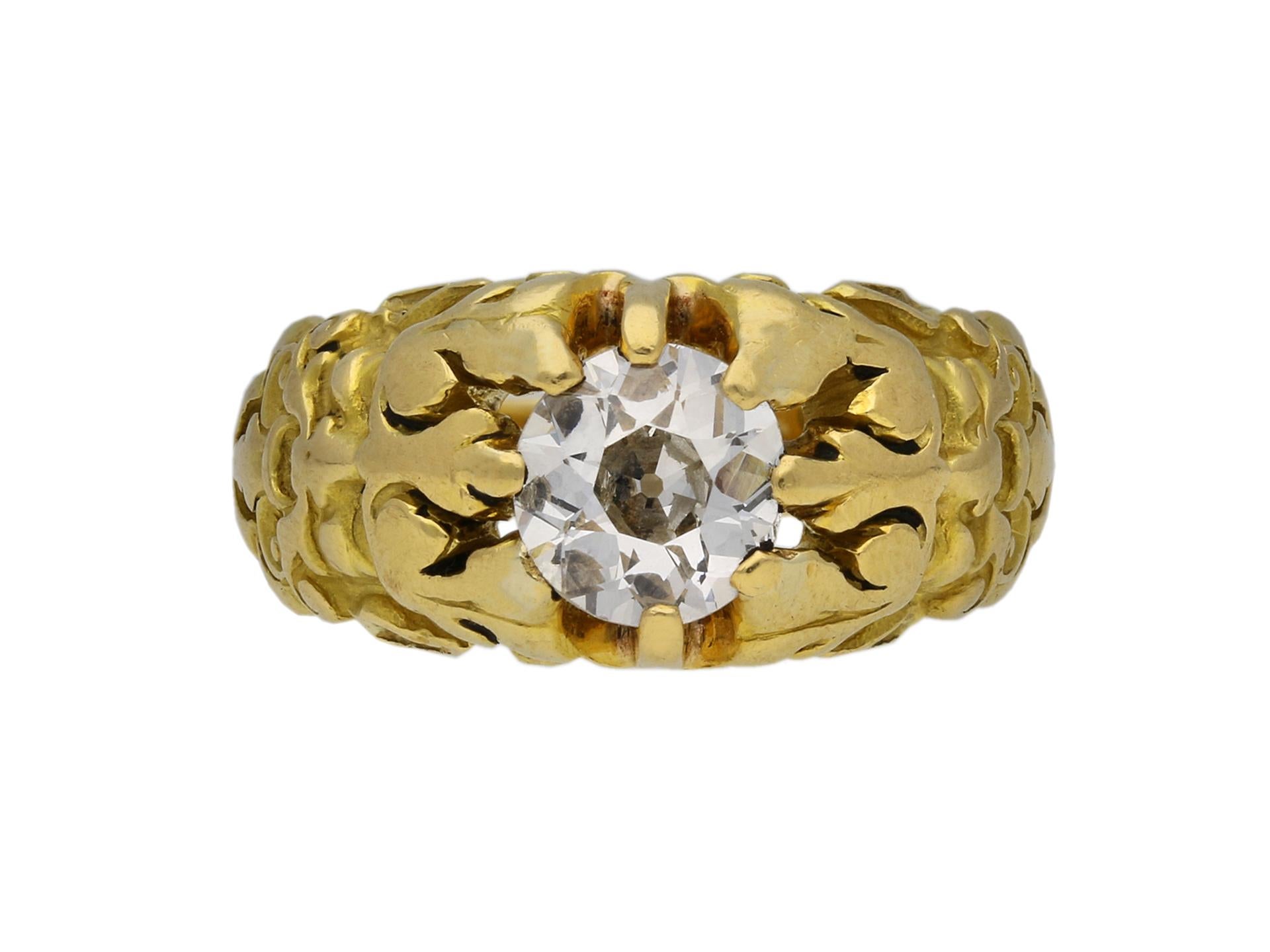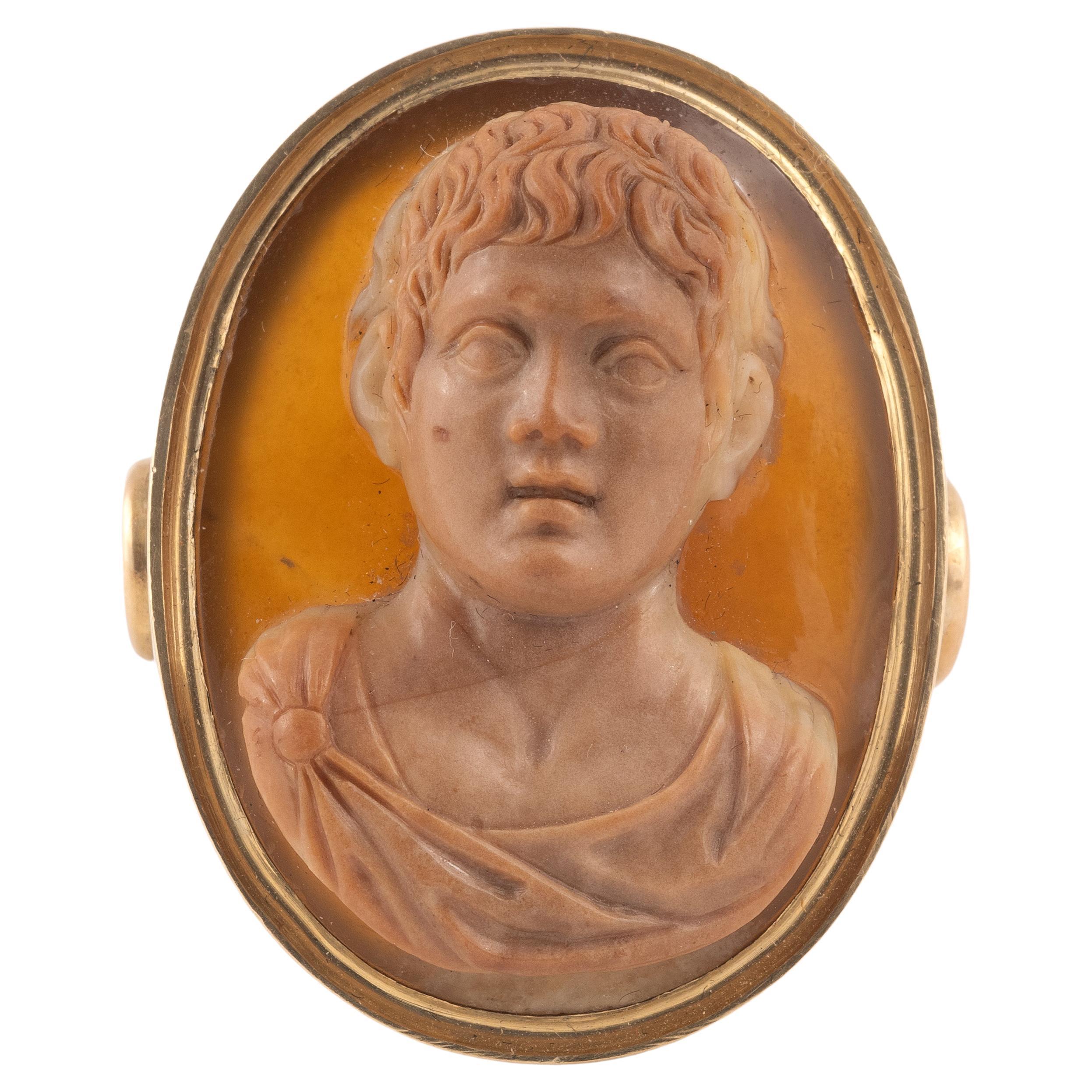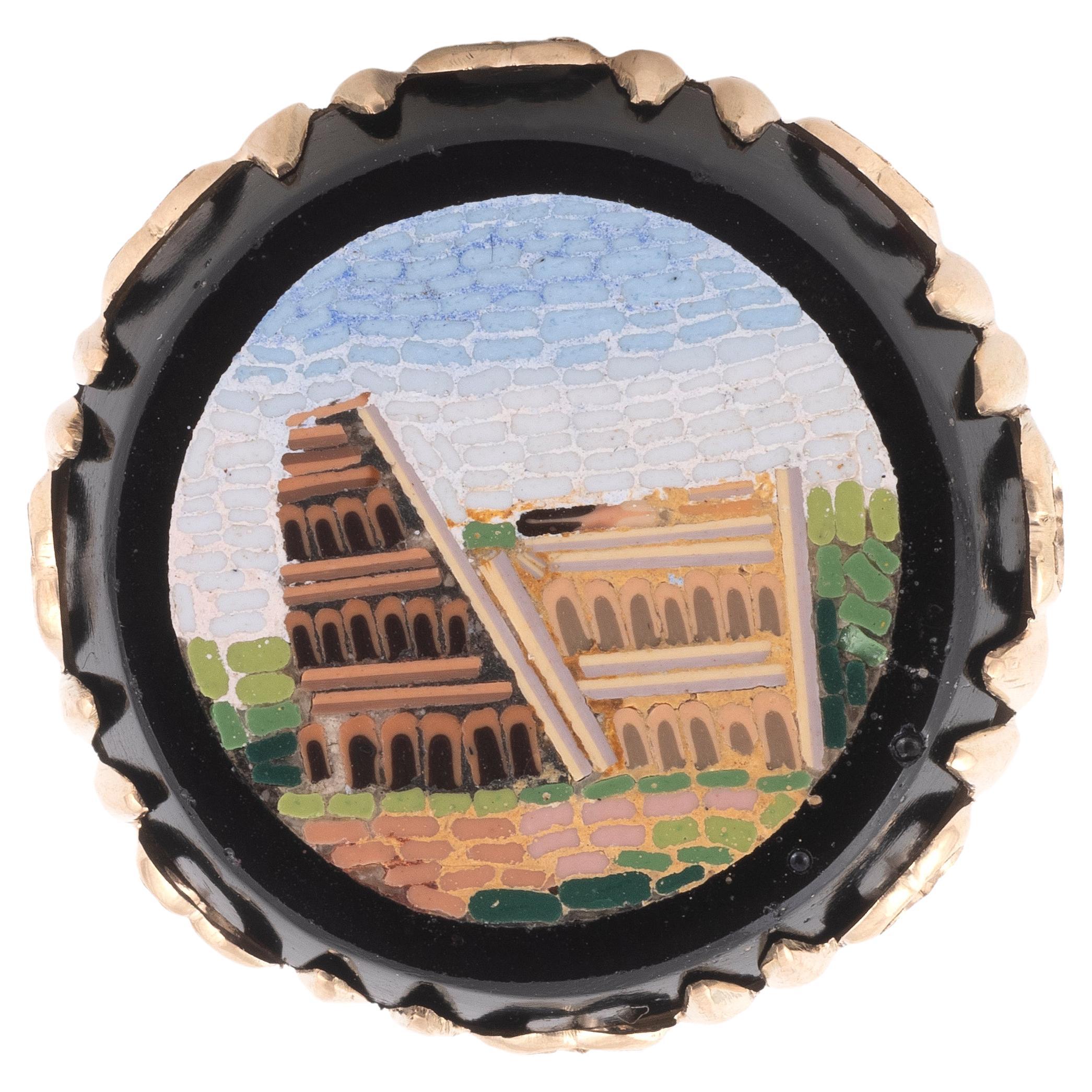Items Similar to Gothic Revival Gold Ring with Joan of Arc by Louis Wièse, Late 19th Century
Video Loading
Want more images or videos?
Request additional images or videos from the seller
1 of 9
Gothic Revival Gold Ring with Joan of Arc by Louis Wièse, Late 19th Century
About the Item
Joan of Arc Ring by Louis Wièse (1852-1930)
France, c. 1890
Gold
Weight 9.3 gr.; Circumference 56.45 mm.; US size 7 3/4; UK size P ½
Cast and chased openwork gold ring with square section hoop, grooved on the lower half and forked at the shoulder to form a triangular frame for a Gothic trefoil insert. The Gothic tracery with scrolling foliage widens into a diamond-shaped bezel with quatrefoil. Inside is a sculpted female head in three-quarter profile, probably Joan of Arc. She wears a helmet, and the collar appears like that of a cuirass. On the upper underside of the bezel is the maker’s mark “WIESE” (1890 to 1925) with the lozenge. The maker’s mark is repeated along the rim, as is the eagle’s head (French guarantee mark for 18 carat gold for goods made in France).
Symbol of French nationalism in the nineteenth century, appropriated by conservative Catholic circles in the 1890s, Joan of Arc (1412–1431) led the country to victory during the Hundred Years’ War against England and was ultimately tried for heresy and burnt at the stake. This ring by the Gothic Revivalist jeweler Louis Wièse celebrates her heroism. Posed in three-quarter profile, Joan proudly wears a helmet and a collar that resembles a cuirass, presenting her as a representative of the people, the savior who rescued France.
Wièse’s image of Joan contrasts with that of Joan as a simple pious girl guided through voices by God’s hand, which lies behind the life-size statue of her made in 1837 by Princess Marie d’Orleans, the sculptor and daughter of King Louis-Philippe of France. Princess Marie’s statue won many accolades and was replicated in numerous casts earlier in the century, a silver statuette designed by Jules and Louis Wièse in c. 1850 and on a chatelaine of the same period by the jeweler François-Desiré Froment-Meurice. Wièse’s imagery is more in line with the gilded equestrian statue sculpted by Emmanuel Frémiet in 1874 so prominently displayed at the Place des Pyramides in Paris. In armor, a triumphant Joan rides forth, bearing the standard of France.
The present ring deliberately mimics the sculpture of a Gothic Cathedral. A quatrefoil frames Joan’s head, just like those used for the Zodiac at Notre-Dame of Amiens. Pierced trefoils reproduce the tracery of Notre-Dame of Paris, sculpturesque crockets define the outer edge of the frame, and finials mark the top and bottom of the quatrefoil.
Literature:
(comparisons) Hellmuth 2014, pp. 131–133, cat. no. 1 (silver statuette of Joan of Arc, Jules and Louis Wièse in c. 1850); Gere/Rudoe 2010, p. 356, fig. 316 (Froment-Meurice chatelaine, Hellmuth 2014, pp. 131–133, cat. no. 1) and in miniature for a chatelaine by the jeweler François-Désiré Froment-Meurice (Gere/Rudoe 2010, p. 356, fig. 316); Chadour-Sampson/Hindman 2016, p. 199 (Wièse ring with standing figure of Joan of Arc).
- Creator:Louis Wièse
- Ring Size:7.75 US, Not Resizable
- Metal:
- Weight:9.3 g
- Style:
- Place of Origin:
- Period:
- Date of Manufacture:1890
- Condition:Wear consistent with age and use.
- Seller Location:Chicago, IL
- Reference Number:
About the Seller
5.0
Vetted Seller
These experienced sellers undergo a comprehensive evaluation by our team of in-house experts.
Established in 1991
1stDibs seller since 2021
5 sales on 1stDibs
Typical response time: 13 hours
- ShippingRetrieving quote...Ships From: Chicago, IL
- Return PolicyA return for this item may be initiated within 3 days of delivery.
More From This SellerView All
- Late 19th-Century Silver and Opal Cape Clasp by Louis WièseLocated in Chicago, ILLouis Wièse Cape Clasp France (Paris), c. 1890 Silver, opals Weight 102.8 gr.; Length 22.23 cm.; individual clasp diameter(s) c. 44 mm. Two openwork roundels in relief show a Chinese dragon head in cast and chased silver, entwined by a serpentine body with bird’s feet and talons. The eyes are formed of opal cabochons. Both roundels are joined by a wire loop and hook as clasp and eight chain links of twisted wire with intersecting plain loops. Traces of gilt remain. On the reverse along the edge of both roundels is the maker’s mark “WIESE” for Louis Wièse. This beguiling cloak clasp...Category
Antique 1890s French Gothic Revival Brooches
MaterialsOpal, Silver
- Ancient Gold Roman Ring with Bust of Tyche 'circa late 1st - 2nd century CE'Located in Chicago, ILRing with Bust of Tyche Roman, late 1st century - 2nd Century AD Gold Weight 4.4 gr.; Circumference 43.45 mm.; US size 2 ¾ ; UK size E ½ Miniature sculpture in ring form of the Gree...Category
Antique 15th Century and Earlier European Classical Roman Cocktail Rings
MaterialsGold
- 19th century Water Squirt Ring in Silver and Gold with Rock CrystalLocated in Chicago, ILSquirt Ring West European, 1800-1900 Silver, gold, rock crystal Weight 9.4 gr.; circumference 60.38 mm.; cylinder length 41.2 mm US size 9 ¼ ; UK size S ¼ Fascinating nineteenth century party piece, incorporating an elegant and sparkling ring Description: Squirt ring made of a hollow silver cylinder with four ornamental bands and a cap with plunger. This holds the liquid, and when the plunger is pulled out and pushed back in the squirt mechanism is triggered. At the other end is a hollow ring through which the liquid flows and then squirts out of a small hole on the band next to the gemstone. The gold ring, angled to the cylinder, has a tubular hoop and a gold round-shaped cup bezel with a silver-set, facetted rock crystal gemstone. The ring is fully functionable. The cylinder lies concealed in the palm of the hand. Punched on the cylinder is a swan, the French guarantee mark for the fineness of silver on items of unknown origin (in use from 1893-1970). Along the gold hoop of the ring are four indistinct hallmarks: a helmeted head (?), two rectangular punch marks, one with lower case ‘g’ in the corner, and traces of two illegible punches. Provenance: Yves Brasseur (26 February—11 August 2005), Ghent, Belgium, a collector of rings who was a Belgian fencer of Olympic stature, having competed in this sport in the Olympics in the 1960s. Literature: The earliest account of a squirt ring dates to about 1770 with the description of a diplomatic incident at the Court of Frederick the Great. The French ambassador M. de Guines belonged to the diplomatic corps in Berlin, the capital of the Prussian Empire. His pompous behavior was widely mocked. Prince Dolgorouki, the Russian ambassador was invited to a gala dinner as a guest of honor with his newly wed bride. She was seated next to the French ambassador whom she squirted with water from a mechanism concealed in the palm of her hand, when he was admiring her jewel. He vowed he would throw a glass of water at her if she continued. The ambassador’s wife ignored his warning, and he in fact put his threat into effect. The guests at the dinner were obliged to keep a discreet silence surrounding this embarrassing occurrence. The fashion for such squirt rings appears to have continued into the nineteenth century, although few examples are known. The designs and materials vary: bronze ring with mask of Silenus in the Victoria and Albert Museum. Silenus, the god of wine-making and drunkenness, appears again on a squirt ring in form of a garnet cameo...Category
Antique 19th Century European Solitaire Rings
MaterialsRock Crystal, Quartz, Gold, Silver
- Late 19th-Century Enameled Brooch with Diamonds by FalizeBy FalizeLocated in Chicago, ILAlexis Falize Brooch with depiction of Renaissance Lady France (Paris), c. after 1894 Gold, silver, enamel, diamonds Weight 10.7 gr.; Width 43.6 mm.; Height 22.3 mm. Gold rectangu...Category
Antique 1890s French Renaissance Revival Brooches
MaterialsDiamond, Gold, Silver, Enamel, 18k Gold
- Georgian Ring as a Token of Love with Seed Pearls and Rose GoldLocated in Chicago, ILRING AS TOKEN OF LOVE England or America, about 1800-1820 Rose gold, pearls Weight 3 gr.; circumference: 56.45 mm.; US size 7.75; UK size P 1/2 The expression of love and friendship is universal in life as in death, and hair mementoes...Category
Antique Early 19th Century English Georgian Cocktail Rings
MaterialsPearl, Rose Gold
- Renaissance Cameo Ring of Galba in a Modern Gold SettingLocated in Chicago, ILRenaissance Cameo Of Galba (?) in Modern Gold Setting Europe, 17th (?) century Onyx and gold Weight: 10.2 g.; circumference: 51.8 mm.; size: US 6, UK...Category
Antique 17th Century European Renaissance Cocktail Rings
MaterialsOnyx, Gold
You May Also Like
- Antique Renaissance Style Turquoise, Ruby 18K Filigree Gold Ring, 19th CenturyLocated in New York, NYBeautiful antique Renaissance style 18K gold ring featuring a fine large oval natural Persian cabochon turquoise gem exquisitely set in a floral filigree setting composed of eight ye...Category
Antique 19th Century Renaissance Cocktail Rings
MaterialsRuby, Turquoise, Gold, 18k Gold, White Gold, Yellow Gold
- Gothic Revival Diamond Solitaire Carved Ring, Attributed to Wièse, circa 1890By Jules & Louis WieseLocated in London, GBGothic revival diamond solitaire carved ring, attributed to Wièse. Set to centre with a round old cut diamond in an open back claw setting with an approximate weight of 1.10 carats, ...Category
Antique 1890s Gothic Revival Solitaire Rings
MaterialsDiamond, Gold
- A Late 18th / Early 19th Century Two-Colour Agate Cameo RingLocated in Firenze, ITA late 18th / early 19th century two-colour Jasper cameo ring depicting a Roman wearing a cloak, mouth slightly open, in gold, cameo 2.1cm high Ring size 9 1/4 Weight: 15,20gr.Category
Antique Late 18th Century Italian Neoclassical Signet Rings
MaterialsAgate, 18k Gold, Yellow Gold
- Antique 19th Century Amethyst Gold RingLocated in Cairo, EGAntique amethyst ring centered with 2 natural pink oval cut amethyst decorted with rose cut diamonds in 18k gold setting with ornament design ring dates back to europe 19th centuryCategory
Antique 19th Century Cocktail Rings
- Gold and Micromosaic Ring Late 19th CenturyLocated in Firenze, IT14kt yellow gold on the lid with a micromosaic of the Colosseum within an black glass frame. Size: 7 Weight: 11,40gr. Top size diameter : 22mmCategory
Antique 1830s Italian Signet Rings
MaterialsGold, 14k Gold
- 19th Century 18 Karat Rose Gold Star RingLocated in Poitiers, FRRing in 18 karat rose gold. This antique ring features a round motif decorated in relief with a 6-pointed star Diameter : 7,9 mm approximately, thickness : 3 mm approximately, width ...Category
Antique 19th Century French Napoleon III Signet Rings
MaterialsGold, 18k Gold, Rose Gold
Recently Viewed
View AllMore Ways To Browse
1837 Ring
Diamond Equestrian
Lozenge Ring
Half Hoop Ring
Antique Cat Jewelry
Gold Half Hoop Ring
Quatrefoil Ring
1 Carat Circle Diamond Ring
Country Ride
Gold Diamond Pyramid Ring
Equestrian Ring
Gothic Antique Rings
Antique Gothic Rings
Lozenge Diamond Ring
King Jeweler
King Jewelers
Chatelaine Jewelry Chatelaine
Chatelaine Jewelry





